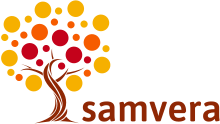Samvera
Samvera, originally known as Hydra, is an open-source digital repository software product. Samvera main components are Fedora Commons, Solr, Blacklight, and HydraHead (a Ruby on Rails plugin and gem, respectively).[1] Each Samvera implementation is called a "head".
 | |
| Operating system | Cross-platform |
|---|---|
| Type | Digital libraries |
| License | Apache License 2.0 |
| Website | samvera |
History
The project was launched in September 2008. The software was developed as a collaboration between Stanford University, the University of Virginia, the University of Hull, and Fedora Commons.[2][3] The stated goal of the project was to "support the rapid development of multiple systems tailored to distinct needs, but powered by a common underlying repository."[3]
In May 2017, the project began discontinuing use of the Hydra name and announced that the "Hydra Project" would become the "Samvera Community."[4]
Project governance
There are three governance bodies. The original collaborators, plus some newer members, form the Samvera Steering Group. That group oversees legal and administrative aspects of the project. A second body is made up of institutional partners. Over two dozen institutions are formal partners. The Samvera developers group is the third group and is made up of contributors to the Samvera software.[5]
Use
Samvera is primarily used in libraries and digital repositories.[1][6] It was originally developed to make use of metadata defined by the Library of Congress's Metadata Object Description Schema (MODS) standard. Samvera implements the Opinionated Metadata gem to create domain-specific languages out of complex XML standards such as MODS.[7] Other metadata standards, such as Dublin Core and Encoded Archival Description (EAD), are also employed in Samvera implementations.[8]
Samvera allows storage of any type of digital files for the purposes of access and/or digital archiving.[6] It is suited to both large and small collections, and is being used in some cases to allow faculty and researchers to self-deposit their own digital research materials.[9][10]
The concept of Samvera "heads" is unique to this repository software. Each head is a Ruby on Rails application that provides a user experience and set of specific functionalities to a certain user community using content and metadata (the body, with the content residing in Fedora and the metadata residing in Solr) that may be shared with other such heads.[11] For example, a faculty member may use a certain Samvera head to crop, fine-tune, and submit a set of images that is relevant to their research. A casual user may use a different Samvera head to browse these images without the clutter of all the photo editing and submission capabilities. Finally, a librarian user may access yet another Samvera head to curate an online exhibit of research at their University, using the photographs submitted by the faculty member but employing a special curatorial interface.
Samvera has been modified to meet special needs, such as the development of GeoHydra at Stanford University.[12]
Derivatives
Due to its extensive list of dependencies, Samvera is difficult for smaller institutions to implement. To make this software more feasible for such institutions, the Digital Public Library of America, Stanford University, and DuraSpace partnered on a grant project from the Institute for Museum and Library Services called "Hydra-in-a-box".[13][14] The goal of this project is to extend the Hydra codebase to "build, bundle, and promote a feature-rich, robust, flexible digital repository that is easy to install, configure, and maintain."[15]
See also
References
- Thomsett-Scott, Beth C. (2016). Thomsett-Scott, Beth C. The Librarian's Introduction to Programming Languages: A Lita Guide, 2016. Rowman and Littlefield. p. 39. ISBN 9781442263321.
- Karen Cariani, "Hydra's Open Source Approach: An Interview with Tom Cramer," The Signal, May 13, 2013, https://blogs.loc.gov/digitalpreservation/2013/05/hydras-open-source-approach-an-interview-with-tom-cramer/ (accessed 25 May 2016).
- Awre, Chris; Cramer, Tom; Green, Richard; McRae, Lynn; Sadler, Bess; Sigmon, Tim; Staples, Thornton; Wayland, Ross. Project Hydra: Designing & Building a Reusable Framework for Multipurpose, Multifunction, Multi-institutional Repository-Powered Solutions. 4th International Conference on Open Repositories. Retrieved 20 July 2016.
- "Hydra's new name is "Samvera"". Hydra Project. May 24, 2017. Retrieved 1 June 2017.
- "Partners and more," Project Hydra, https://projecthydra.org/community-2-2/partners-and-more/ (accessed 26 May 2016).
- "About the digital repository". Digital Repository. University of Hull. Retrieved 20 July 2016.
- Zumwalt, Matt (9 February 2011). "Opinionated Metadata (OM): Bringing a Bit of Sanity to the World of XML Metadata". code4lib 2011. code4lib. Retrieved 20 July 2016.
- "Metadata". Hydra Project. 1 September 2012. Retrieved 20 July 2016.
- "Hydra/Fedora Repository". Yale University Library. 2015. Retrieved 20 July 2016.
- "Scholarsphere". Penn State University Libraries. 18 February 2016. Retrieved 20 July 2016.
- Awre, Chris; Duke, Monica (2013). "Storing and sharing data in an institutional repository: Hydra@Hull". DCC RDM Services case studies. Edinburgh: Digital Curation Centre. Retrieved 16 December 2016.
- Hardy, Darren; Durante, Kim (2014-07-21). "A Metadata Schema for Geospatial Resource Discovery Use Cases". The Code4Lib Journal (25). ISSN 1940-5758.
- "Far-reaching "Hydra-in-a-Box" Joint Initiative Funded by IMLS". Digital Public Library of America. 15 April 2015. Retrieved 20 July 2016.
- Tennant, Roy (15 April 2015). "Ambitious "Hydra-in-a-Box" Effort Funded by IMLS". The Digital Shift. Retrieved 20 July 2016.
- "Hydra-In-a-Box". Project Hydra. Retrieved 20 July 2016.